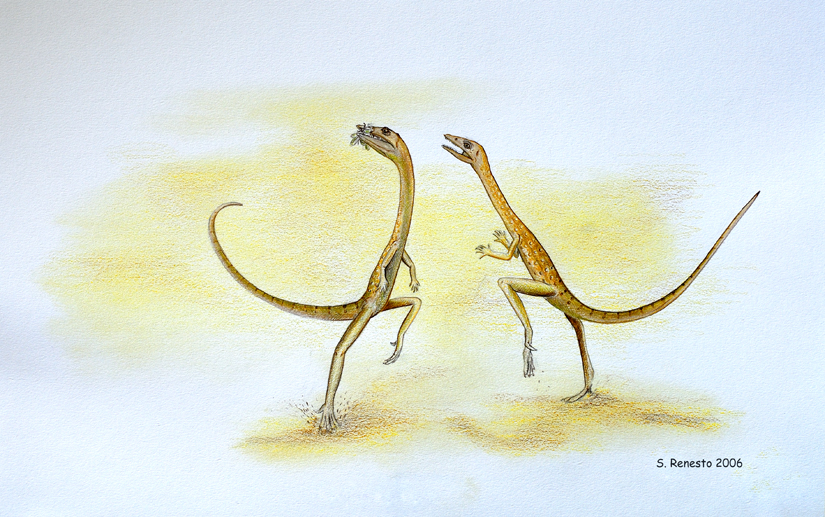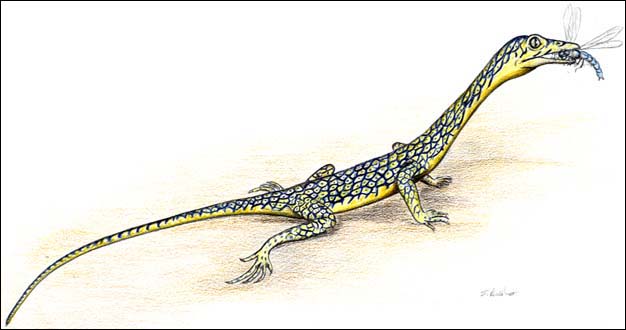[Recent Entries][Archive][Friends][User Info]
February 16th, 2012
| February 16th, 2012 | |
|---|---|
| 08:23 pm [industrialterro] [Link] |
Malerisaurus Malerisaurus is an extinct genus of prolacertiform archosauromorph known from Andhra Pradesh of India and Texas of the USA. Malerisaurus is known from the holotype ISIR 150, two articulated and almost complete skeletons which were discovered as the presumable gastric contents of two skeletons of Parasuchus hislopi. It was collected from the Lower Maleri Formation, dating to the late Carnian or early Norian stage of the Late Triassic. Malerisaurus robinsonae was a small archosauromorph, probably capable of climbing trees and swimming. The skull has some adaptations to a carnivorous diet, but is nevertheless unspecialised and probably more of an insectivore. Malerisaurus, seen as a diapsid skull, shows primitive and advanced facies in its unossified laterosphenoid, absence of antorbital and mandibular fenestrae, gracile form, primitive girdles, elongated cervicals and absence of dermal armour. The suborder Prolacertiformes currently represents four families: Sharovipterygidae, Protorosauridae, Prolacertidae and Tanystropheidae. Chatterjee provisionally regarded Malerisaurus as close to Protorosaurus. A second species, M. langstoni, is known from the holotype TMM 31099-11, a partial but poorly preserved skeleton. It was collected in the Otis Chalk Quarry 2 (TMM 31099 locality) from the Colorado City Formation, Chinle Group, dating to the early Carnian stage of the Late Triassic, about 228-227.5 million years ago. It was found in the Howard County of Texas.
Tags: Вымершие рептилии, Триас, архозавроморфы, диапсиды, проторозавры |
| Time | Event |
| 08:41 pm [industrialterro] [Link] |
Macrocnemus Macrocnemus is an extinct genus of prolacertiform reptile from the Middle Triassic of Europe. Two species have been named, the type species M. bassanii and the species M. fuyuanensis. Macrocnemus bassanii (Nopcsa 1931) Ladinian, Middle Triassic ~220mya, is known from several specimens ranging in size and varying in morphology. Romer (1970) considered Macrocnemus a lepidosaur. Carroll (1988) placed it with Protorosaurus and Prolacerta, which is where most current workers consider it, but that would be an error. Here, following a larger phylogenetic analysis, Macrocnemus is derived from a sister to the basal lizard, Huehuecuetzpalli. The smallest Macrocnemus, BES SC 111, is also the most primitive. Larger species are considered below. As in HuehuecuetzpalMacrocnemus bassanii (Nopcsa 1931) Ladinian, Middle Triassic ~220mya, is known from several specimens ranging in size and varying in morphology. Romer (1970) considered Macrocnemus a lepidosaur. Carroll (1988) placed it with Protorosaurus and Prolacerta, which is where most current workers consider it, but that would be an error. Here, following a larger phylogenetic analysis, Macrocnemus is derived from a sister to the basal lizard, Huehuecuetzpalli. The smallest Macrocnemus, BES SC 111, is also the most primitive. Larger species are considered below. As in Huehuecuetzpalli, this clade practices isometric growth, so all morphological differences are indeed valid traits, not signs of immaturity within a single genus or species. BES SC 111 (Renesto & Avanzini 2002) ~30 cm, was previously described as a juvenile, but has a tooth count a third higher than in the larger T4822. Phylogenetically it appears at the base of a clade that includes all the larger specimens of Macrocnemus, which in turn lead to Tanystropheus, Dinocephalosaurus and Langobardisaurus + Tanytrachelos. BES SC 111 also leads to Jesairosaurus and Cosesaurus. Distinct from Huehuecuetzpalli, the rostrum was further elongated, the postorbital portion was shortened and the jugal produced a quadratojugal process. The teeth were all small, numerous and in contact with one another. The maxilla was nearly as tall as the orbit. The cervicals series of eight was robust and elongated, clearly distinct from the dorsals. All neural spines were short. Only two sacrals were present, but adjoining vertebrae had broad transverse processes. The chevrons were further reduced and many were appressed to their centrum. Gastralia were present. The coracoid and scapula had no fenestrations and the short scapula had a posterior lean. The two centrale appear to have migrated to the medial carpus but remain posterior to distal carpal I. Manual digit V was shorter than metacarpal IV.
Tags: Вымершие рептилии, Триас, архозавроморфы, диапсиды, проторозавры |
| Previous Day | 2012/02/16 [Archive] |
Next Day |






